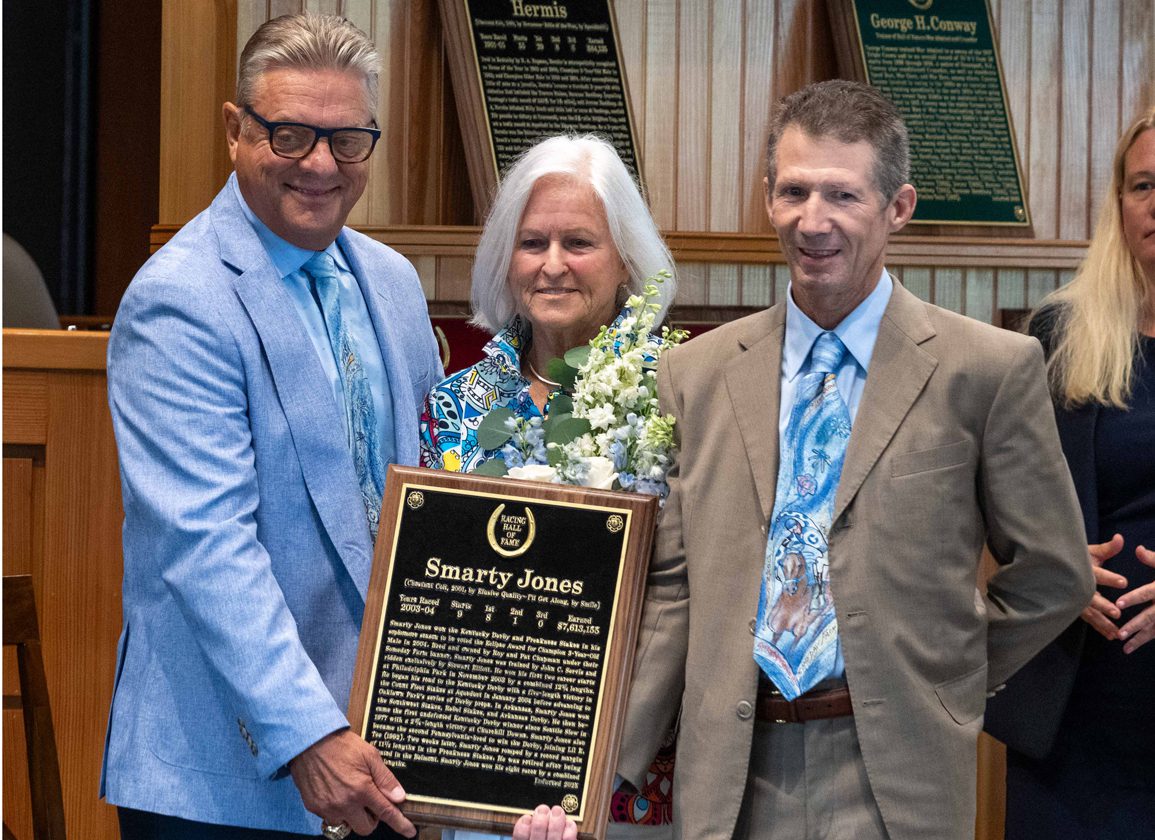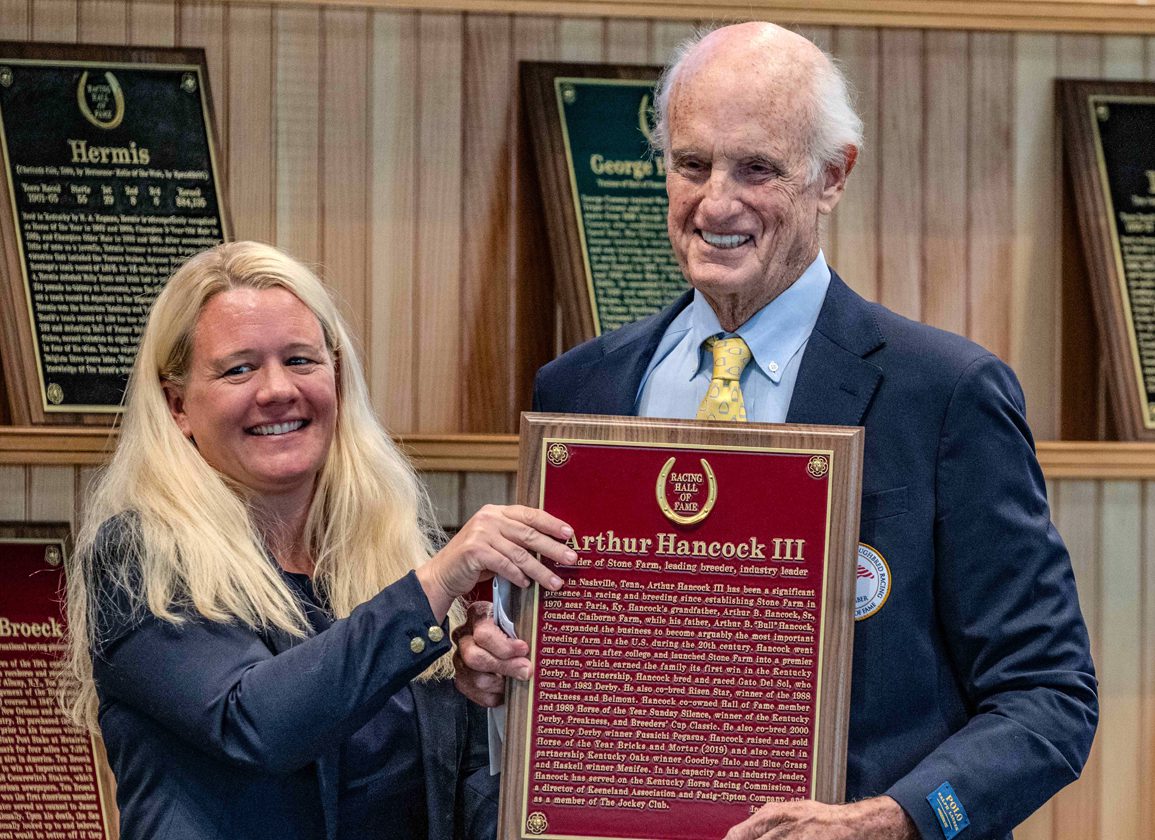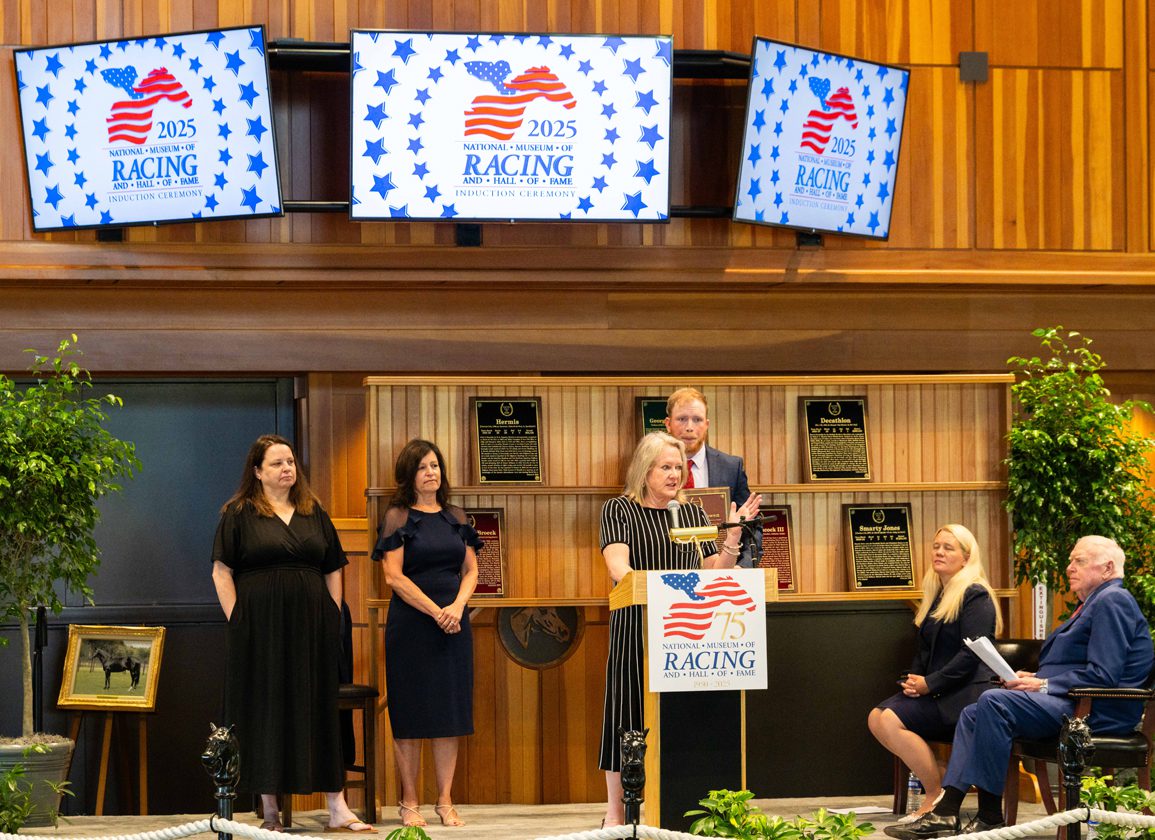SARATOGA SPRINGS, NY–Late in the Hall of Fame induction ceremony Friday, master of ceremonies Tom Durkin moved close to the microphone and declared it time for the “Smarty Party” to begin. The crowd that filled the Fasig-Tipton sales pavilion for racing’s annual feel-good day roared its approval.
Within a few minutes, Smarty Jones (Elusive Quality), winner of the 2004 GI Kentucky Derby and the GI Preakness Stakes officially joined the National Museum of Racing’s Hall of Fame. The Pennsylvania-bred had been eligible for the Hall of Fame since 2010, but did not have enough support from the nominating committee to make it on the ballot until this year. He was the only one of the 16 contemporary candidates on the ballot to receive the requisite 50% plus one vote.
Pat Chapman, who bred and raced Smarty Jones with her late husband Roy “Chappy” Chapman, delivered the first of three acceptance speeches. She was followed by trainer John Servis and jockey Stewart Elliott.
“I heard through the grapevine that if they could just get his name on the ballot, that the voters would do the rest. I think that’s what happened,” she said. “Thank you so much to all you voters who voted in the end. This is an honor that I wasn’t sure I’d ever see. I wasn’t sure I was ever going to live long enough to appreciate this day, to appreciate this honor and to be up here to thank all of you so much for your wonderful support for this horse.”
Six other individuals were formally inducted during the ceremony. The 1900-1959 Historic Review Committee elected trainer James H. Conway and the racehorses Decathalon and Hermis. The Pillars of the Turf Committee elected Edward L. Bowen, Arthur B. Hancock III and Richard Ten Broeck.
The museum was formed in 1950 in Saratoga and is celebrating its 75th anniversary. A total of 28 members of the Hall of Fame attended the induction ceremony, including jockey Laffit Pincay, Jr., who was inducted in 1975, and 92-year-old jockey Bill Boland, winner of the 1950 Kentucky Derby and GI Belmont Stakes aboard Middleground.
Pat Chapman noted how she and her husband met while they were being treated for addictions.
“Recovery from addictions is possible,” she said.
Smarty Jones won his first two career starts at Philadelphia Park, then captured the Count Fleet Stakes at Aqueduct. He completed his three-race winning tour of Oaklawn Park with a victory in the then-GII Arkansas Derby. He continued his magical ride with a 2 3/4-length triumph at Churchill Downs over Lion Heart. He was the first unbeaten Derby winner since Seattle Slew in 1977. Two weeks later, Smarty Jones blew away the field in the Preakness with an 11 1/2-length score. In the Belmont Stakes, his bid to end the long Triple Crown drought came up short in the final sixteenth of the mile when he was passed by Marylou Whitney’s Birdstone.
The Belmont was Smarty Jones’ final start and he was retired to stud with an 8-1-0 record from nine races. He won his eight races by a combined 47 1/2 lengths.
Smarty Jones was a very big Pennsylvania story that became a national story. Pat Chapman thanked the many fans of the colt that carried her mother’s nickname.
“Wow. Unbelievable to congratulate all the inductees and all of those who’ve gone before us,” she said. “What a room full of fabulous people. Congratulations to all of us. It’s unbelievable that we’re standing here today as the breeder and owner of Smarty Jones, who was on Time magazine’s list of the most influential people back in 2004. He graced the cover of Sports Illustrated and many, many magazines and newspapers.”
Servis was not very well known until Smarty Jones came along.
“I had the privilege of witnessing first-hand, the heart, determination and sheer brilliance of this remarkable horse,” Servis said. “Smarty Jones wasn’t just a champion, he was a horse who captured the imagination of racing fans everywhere. From his humble beginnings at Philadelphia Park to his thrilling victories in the Kentucky Derby and in the Preakness, he carried the hopes of the entire sport on his powerful shoulders. His grit, his unrelenting will to win, and his undeniable charisma made him unforgettable.
“But beyond his talent, Smarty Jones had something even more special. He had a connection with people. He wasn’t just a race horse. He was a hero. Whether it was his rags-to-riches story, his blue-collar roots, or the way he fought every step of the way, fans saw themselves in him. He reminded us all why we love this sport.”.
Hancock Legacy Honored
Hancock was born in Nashville, TN, and is a member of one of the sport’s most distinguished families. His grandfather, Arthur. B. Hancock Sr. founded Claiborne Farm and his father Arthur B. “Bull” Hancock grew the business to become one of the most important breeding farms in the world. For six decades, Hancock has been a significant presence in American racing and breeding through his establishment of Stone Farm in 1970 near Paris, Ky.
“To be honored as a Pillar of the Turf and following the footsteps of my father and grandfather is indeed a profound and humbling experience,” he said.
After graduating from Vanderbilt University, Hancock moved to the New York City area where he worked for a year as an apprentice under future Hall of Fame trainer Edward A. Neloy. He then returned to Claiborne as the assistant broodmare and yearling manager under the tutelage of his father. While Hancock’s younger brother, Seth, would eventually take over the running of Claiborne Farm, Arthur went out on his own, leasing 100 acres and launching Stone Farm into a top-level breeding and racing operation, which earned the family its first win in the Kentucky Derby. The farm has grown to more than 2,000 acres and has produced over 200 stakes winners.
Arthur B. Hancock III | Mike Kane
That Derby victory came in 1982 with Gato Del Sol in a breeding and racing partnership with one of his longtime clients, Manhattan real estate broker Leone J. Peters. Hancock and Peters also teamed up to breed Risen Star, winner of the 1988 Preakness Stakes and Belmont Stakes. Through H-G-W Partners, Hancock owned and raced Hall of Fame member and 1989 Horse of the Year Sunday Silence, whose wins included the Kentucky Derby, Preakness Stakes, and Breeders’ Cup Classic. Hancock also co-bred 2000 Kentucky Derby winner Fusaichi Pegasus. Hancock raised and sold a second Horse of the Year, Bricks and Mortar (2019), who was campaigned by Klaravich Stables. He has also raced in partnership Kentucky Oaks winner Goodbye Halo and Blue Grass Stakes and Haskell Invitational winner Menifee, among others.
Hancock thanked his wife Stacy and their six children, his friends and longtime clients and the employees at Stone Farm for the success that carried him to the Hall of Fame.
“I like to pay tribute to my father, Bull Hancock, for imparting to me a deep respect and admiration for the horse and the love of the game. He always said, ‘Work hard, be honest, and remember that you have just one reputation, and once it’s gone, it’s gone. I think Thoroughbred racing would be wise to remember his words. We should never forget that the horse is the sport. He is front and center. He is all important, majestic, spirited and brave. The horse is the reason we are all gathered here today.”
Hancock said it is vitally important for horses to be treated well to maintain public interest in racing.
“We have a saying in Kentucky, ‘If you take care of the land, the land will take care of you,’” he said. “I believe it’s the same for our sport. If you take care of the horse, the horse will take care of you.”
Conway Did It The Hard Way
Conway spent his life in racing and climbed the ladder from an exercise rider to the trainer of Riddle’s powerful stable from 1926 until June 1939, when he retired a few days before his death. Topping the list of standouts he handled for Riddle was War Admiral, the 1937 Triple Crown champ and Hall of Fame member. War Admiral won 21 of 26 starts, most of them in major stakes. His Triple Crown sweep was part of an 11-race unbeaten streak. He was retired a week before Conway announced he was stepping down for health reasons. Conway also trained Hall of Famer Crusader, as well as Speed Boat, War Glory and War Relic.
In 1917, Conway joined the Glen Riddle Racing Stable as an assistant to Hall of Fame trainer Louis Feustel. He was the stable foreman during the career of Man o’ War legendary two seasons of competition in 1919 and 1920. In 1926, he succeeded Gwyn Tompkins, who retired due to poor health, as the head trainer. Conway took over Crusader, and saddled the 3-year-old Man o’ War colt to nine stakes victories that season: Suburban Handicap, Belmont Stakes, Dwyer, Cincinnati Derby, Huron Handicap, Jockey Club Gold Cup, Havre de Grace Handicap, Maryland Handicap, Riggs Handicap.
Bowen Comes Home
Bowen, who died on Jan. 20 at the age of 82, was a prolific racing journalist and historian for more than 60 years, was chairman of National Museum of Racing’s Hall of Fame Nominating Committee for 37 years and served the sport in a number of other capacities. For 24 years he served as president of the Grayson-Jockey Club Research Foundation.
Born in West Virginia and raised in Florida, Bowen embraced racing in his youth. He was an Eclipse Award-winning writer, editor in chief of The Blood Horse magazine, the author of 22 books about horse racing and countless articles on the sport.
Bowen’s wife Ruthie described how he transferred the from the University of Florida to the University of Kentucky after landing a staff writing job at The Blood Horse.
“He loved Thoroughbreds, he loved people involved with Thoroughbreds, and he got to go to major races,” she said. “Pretty much his dream job.”
Ruthie Bowen speaks about her late husband, Pillar of the Turf inductee Ed Bowen | Mike Kane
From 1994 until his retirement at the end of 2018, Bowen’s role with Grayson included raising funds to provide $22 million for research projects that benefited all horses, not just Thoroughbreds. He oversaw the first year that the foundation was able to give out $1 million for equine research.
“He was able to use his communication skills, his love of the game and support of industry leaders to morph himself into becoming a very effective fundraiser,” Ruthie Bowen said. “I think he really liked the feeling that he was contributing to the well-being of horses, and therefore ultimately contributing to the well-being of the sport.”
A trustee of the National Museum of Racing and Hall of Fame, Bowen also chaired the Museum’s Historic Review, Steeplechase Review, Pillars of Turf, and Joe Hirsch Media Roll of Honor committees at various committees. Though he certainly deserved to be elected to the Joe Hirsch Media Roll of Honor, he refused to be considered because he chaired the committee. Two years ago, though, he was the inaugural recipient of the Cornelius Vanderbilt Whitney Award for meritorious contributions to the Museum. The prior year, Bowen was the Thoroughbred Club of America’s Honor Guest.
Bowen’s many other honors included the National Turf Writers Association’s Walter Haight Award, Kentucky Thoroughbred Owners and Breeders’ Charles Engelhard Award, Pimlico’s Old Hilltop Award.
Figures Of Yesteryear Recognized
Decathlon (Olympia–Dog Blessed, by Bull Dog), was bred in Kentucky by the Nuckols Brothers and was purchased at Keeneland for $15,500 by Robert J. Dienst, the owner of Beulah Park in Ohio. Trained by Rollie Shepp, he competed for three seasons, 1955-1957, and compiled a record of 25-8-1 from 42 starts. He won 18 stakes and was the champion sprinter in 1956 and 1957.
During his career, Decathlon had win streaks of six and five races. During the six-race win streak that stretched from 1956 into 1957, Decathlon carried as much as 135 pounds to victory in the Hialeah Inaugural. He won eight races in his career carrying 130 pounds or more. He won races at nine tracks.
Following his racing career, Decathlon stood at Darby Dan Farm in Kentucky, where he sired 165 winners from 253 foals, including 12 stakes winners.
Bred in Kentucky by Hiram Berry, Hermis (Hermence–Katy of the West, by, Spendrift) raced from 1901 through 1905 with a record of 29-8-6 from 55 starts and earnings of $84,155. The chestnut colt competed for a number of owners and had three trainers: Charles Hughes (July 1901-August 1902), Jack McCormick (August 1902-October 1902), and Alexander Shields (June 1903-July 1905). His final owner, Edward R. Thomas paid a record $60,000 for him after he had won his final nine races of 1902, three of them at Saratoga, including the Travers. Overall, he won 15 stakes and earned victories at eight tracks.
Ten Broeck, was born on 1811 in Albany, NY, 52 years before racing started in nearby Saratoga Springs, and developed into one of American racing’s most prominent and accomplished figures in the 19th century, enjoying success as a racehorse and racetrack owner, Thoroughbred breeder, and international racing pioneer. The Ten Broeck family traces its American roots to the Revolutionary War, as both his grandfathers served with distinction in the fight for independence.
After resigning as a student at West Point following a dispute with an instructor, Ten Broeck set off for what became a colorful career, beginning as a gambler. During the 1830s, Ten Broeck became associated with Col. William R. Johnson, one of America’s most renowned racing figures. By 1840, he was racing horses in his own colors in St. Louis, New Orleans, and New York. Ten Broeck’s stable began to rise to prominence and he was known as a leading turfman in the South when he took over management of the Bingaman (Louisiana) and Bascombe (Alabama) courses in 1847. In 1851, he purchased Metairie Race Course in New Orleans for $27,000. Under his management, Metairie became the premier track in the country in the decade prior to the Civil War. Ten Broeck emerged as a top promoter and developed stakes races. In 1853, he purchased the colt Darley, that he renamed Lexington. It proved to be an astute purchase as Lexington was a top racehorse, and in retirement was the 16-time leading sire in the U.S. He was a member of the Hall of Fame’s first class in 1955.
Ten Broeck went on to a successful career as an owner in Great Britain and was the first American member of the English Jockey Club.



